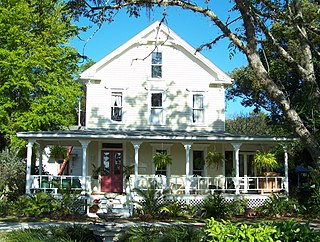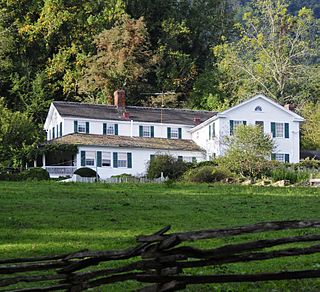
Horne Creek Farm is a historical farm near Pinnacle, Surry County, North Carolina. The farm is a North Carolina State Historic Site that belongs to the North Carolina Department of Natural and Cultural Resources, and it is operated to depict farm life in the northwest Piedmont area c. 1900. The historic site includes the late 19th century Hauser Farmhouse, which has been furnished to reflect the 1900-1910 era, along with other supporting structures. The farm raised animal breeds that were common in the early 20th century. The site also includes the Southern Heritage Apple Orchard, which preserves about 800 trees of about 400 heritage apple varieties. A visitor center includes exhibits, a gift shop and offices.

Kanuga Conference Center is affiliated with the Episcopal Church in the United States of America and the Anglican Communion. It is located on 1,400 acres (5.7 km2) near Hendersonville, North Carolina, with scenic Kanuga Lake at its center. Yearly, more than 35,000 guests utilize the facilities, which include the conference center, Camp Kanuga, Camp Bob, and the Mountain Trail Outdoor School.

The Moses J. Taylor House, also known as the Dreamspinner Bed and Breakfast Inn, is a historic home in Eustis, Florida that has been operated as a bed and breakfast since about 1997. It was built in about 1881 as a two-and-a-half-story private home with elements of Italianate architecture. It was on a large property surrounded by citrus groves of the Taylor family until the land was split off for residential subdivisions built in the 1950s and 1960s.

In the law regulating historic districts in the United States, a contributing property or contributing resource is any building, object, or structure which adds to the historical integrity or architectural qualities that make the historic district significant. Government agencies, at the state, national, and local level in the United States, have differing definitions of what constitutes a contributing property but there are common characteristics. Local laws often regulate the changes that can be made to contributing structures within designated historic districts. The first local ordinances dealing with the alteration of buildings within historic districts was enacted in Charleston, South Carolina in 1931.
George Washington Logan was a North Carolina politician who served in the Confederate States Congress during the American Civil War as a peace and Unionist candidate.

Hampton Plantation, also known as Hampton Plantation House and Hampton Plantation State Historic Site, is a historic plantation, now a state historic site, north of McClellanville, South Carolina. The plantation was established in 1735, and its main house exhibits one of the earliest known examples in the United States of a temple front in domestic architecture. It is also one of the state's finest examples of a wood frame Georgian plantation house. It was declared a National Historic Landmark in 1970.

The Black Moshannon State Park Historic Districts are three separate historic districts on the National Register of Historic Places (NRHP) at Black Moshannon State Park in Rush Township, Centre County, Pennsylvania in the United States. The structures in the historic districts were constructed in the 1930s during the Great Depression by the Civilian Conservation Corps (CCC). The three districts are: the Beach and Day Use District, with 18 contributing structures, including 11 different picnic pavilions, concession building, bathhouse, museum, and four open pit latrines; the Family Cabin District with 16 contributing properties, including 13 cabins, one lodge and two latrines; and the Maintenance District with four contributing properties, including a storage building, three-bay garage, gas pump house, and ranger's residence.

Cannondale Historic District is a historic district in the Cannondale section in the north-central area of the town of Wilton, Connecticut. The district includes 58 contributing buildings, one other contributing structure, one contributing site, and 3 contributing objects, over a 202 acres (82 ha). About half of the buildings are along Danbury Road and most of the rest are close to the Cannondale train station .The district is significant because it embodies the distinctive architectural and cultural-landscape characteristics of a small commercial center as well as an agricultural community from the early national period through the early 20th century....The historic uses of the properties in the district include virtually the full array of human activity in this region—farming, residential, religious, educational, community groups, small-scale manufacturing, transportation, and even government. The close physical relationship among all these uses, as well as the informal character of the commercial enterprises before the rise of more aggressive techniques to attract consumers, capture some of the texture of life as lived by prior generations. The district is also significant for its collection of architecture and for its historic significance.

The High Hampton Inn Historic District is a historic estate, resort, and national historic district nestled in the mountains of western North Carolina, in the Cashiers Valley in Jackson County, North Carolina. Originally the summer home of the prosperous Hampton family of South Carolina, the property was listed on the National Register of Historic Places in 1991.

Portage Point Inn Complex is a resort hotel located at the western end of Portage Lake at Portage Point, Michigan. In October 1985, this 1902 resort hotel and its associated buildings was added to the National Register of Historic Places. It operates today as the Portage Point Resort.

Terry-Ketcham Inn is a historic inn and tavern located at Center Moriches in Suffolk County, New York. It was built about 1693, expanded about 1710 and 1790, and is a two-story, nine-bay by two-bay frame structure with a rear wing and gable roof. The original structure was built as a two-bay by three-bay, single-story timber-frame cottage. In about 1710 a three-bay by two-bay timber frame half-house was built to the north of the original structure. A 1790 building program tripled the size of the structure.

The Sheldon Inn was a two-story apartment building located at 44134 Michigan Avenue, in Sheldon Corners in Canton Township, Michigan. It was built in 1825, and previously used as a single-family home and a travelers' inn. It was listed on the National Register of Historic Places in 2000. It was demolished in 2021.

The Brigham Young Winter Home and Office is a historic house museum located in St. George, Utah. The home and office once belonged to Brigham Young, the foremost Mormon pioneer and second president of the Church of Jesus Christ of Latter-day Saints. During Young's later years, his arthritis precluded him from spending winters in the Salt Lake City region, so a winter home in St. George—located in the arid Dixie region of the state—was acquired. He seasonally occupied the property from 1873 to 1877.

The Lake of the Woods Ranger Station is a United States Forest Service compound consisting of eight buildings overlooking Lake of the Woods in the Fremont-Winema National Forests of southern Oregon. All of the ranger station structures were built by the Civilian Conservation Corps between 1937 and 1939. Today, the compound serves as a Forest Service work center, and the old ranger station office is a visitor center. The ranger station is listed on the National Register of Historic Places.
Pine Island Plantation Complex is a historic hunting plantation complex and national historic district located on Pine Island near Frogmore, Beaufort County, South Carolina. The district encompasses six contributing buildings and one contributing sites, and is an early-20th century hunting plantation. The main house at Pine Island was built about 1904, and is a two-story frame structure built on an existing tabby foundation. The front façade features a full-width two-story porch. Also on the property are the contributing cottage, a toolshed/doghouse, a barn, a pumphouse, an automobile garage, and causeway.

Sherrill's Inn is a historic home located near Fairview, Buncombe County, North Carolina. It is a four bay by two bay, log house of the saddle-bag variety which has been raised to two stories and weatherboarded. Attached to it is an originally separate two-story, log building, two bays wide and two bays deep. Also on the property are a contributing stone spring house and log meathouse. The building was built about 1845, and used as an inn throughout much of the 19th century.

Washington Mills-Mayodan Plant, also known as Mayo Mills, Washington Group-Mayodan Plant, and Tultex Corp.-Mayodan Plant, was a historic textile mill and national historic district located at Mayodan, Rockingham County, North Carolina. It encompassed four contributing buildings and two contributing structures in the town of Mayodan. The main spinning mill was built in 1895, and was a three-story, rectangular brick structure with a low-pitched gable roof. The mill was expanded several times between 1897 and 1954. It featured a four-story, one bay, tower with an open belfry at the top. Also on the property were the contributing knitting mill (1911), transformer house, railroad underpass, railroad spur, and frame wood shed. The mill closed in 1999.

George W. Logan House, also known as Jobe Hill, is a historic home located near Rutherfordton, Rutherford County, North Carolina. It built about 1842, and is a one-story, five-bay, Georgian plan frame dwelling. It is sheathed in weatherboard, has a side gable roof, and two rebuilt exterior end chimneys. It was enlarged and remodeled in the 1890s and in 1985. Also on the property are the contributing brick well house, dairy, outhouse, smokehouse, granary, log double corncrib, and a large log barn. It was the home of prominent North Carolina politician George Washington Logan (1815-1889).

Lacey-Keosauqua State Park is located southwest of Keosauqua, Iowa, United States. The park is located along the Des Moines River in Van Buren County. First dedicated in 1921, it is the largest state park in size in Iowa. In 1990, three areas were named nationally recognized historic districts and listed on the National Register of Historic Places.






















